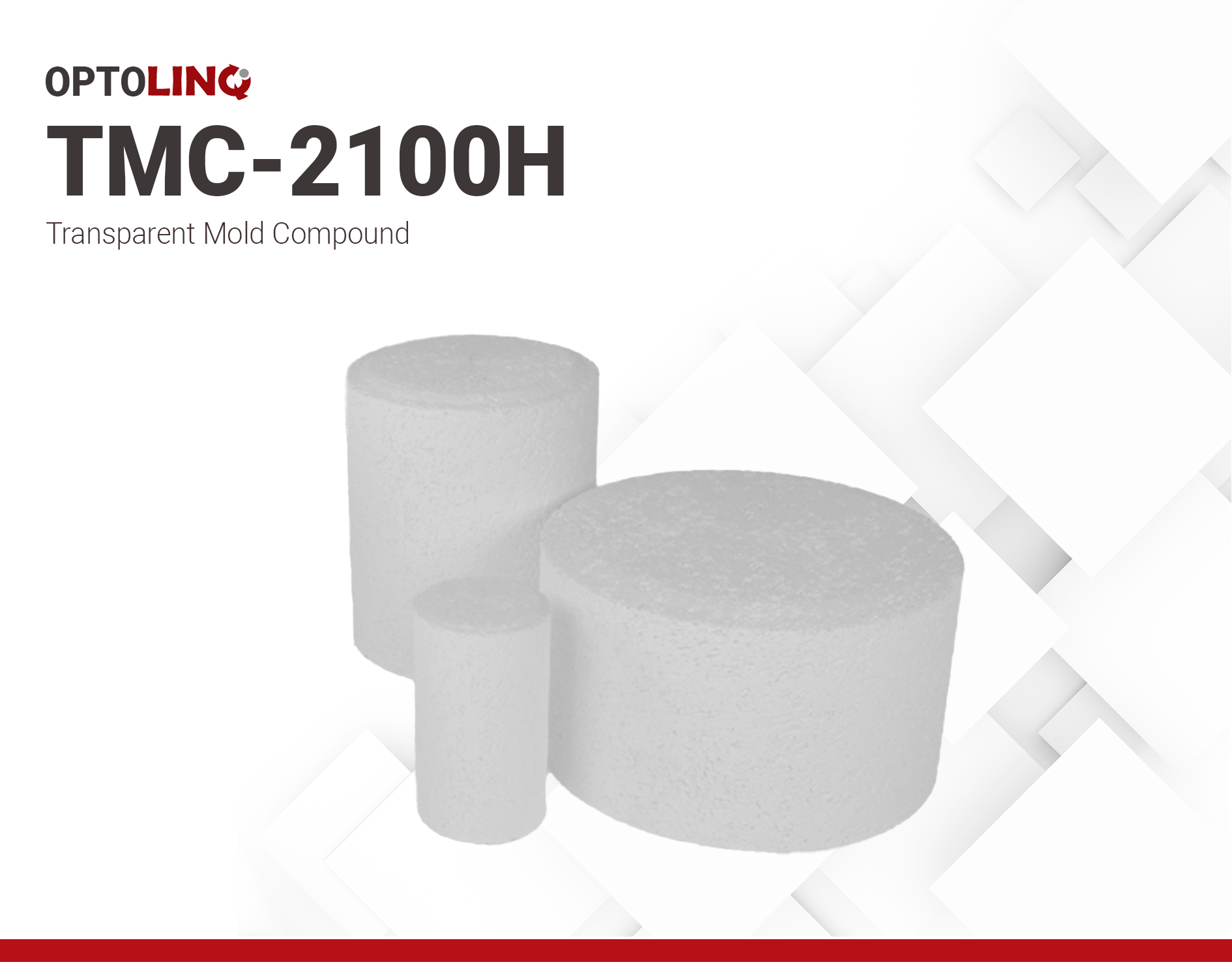OPTOLINQ TMC-2100H | Transparent Mold Compound
- Optimal spiral flow
- Low moisture absorption
- Superior moldability and reliability
Product Description
OPTOLINQ TMC-2100H is an optically clear epoxy molding compound specifically designed for the encapsulation of applications that demand high moldability and optical performance. Its optimized wax formulation delivers improved self-release, enabling easier demolding and better cavity fill.
OPTOLINQ TMC-2100H exhibits excellent resistance to moisture and retains stable performance under high heat and humidity. With superior processability and long-term reliability, it ensures consistent quality and precision in optoelectronic device packaging.
TMC-2100H is compatible for both emitter and receiver functionality for IR-sensitive applications, where it effectively blocks near-infrared (NIR) light above 1100 nm while allowing visible light (400–700 nm) to pass—making it well-suited for ambient light sensors and other visible-light-only applications.
OPTOLINQ TMC-2100H comes in different sizes to meet various mold design requirements. Contact us for custom sizes or other specific requirements.
Key Features
- Visible Light Transmission with NIR Blocking: Enables precise sensing by allowing visible light through while filtering out NIR wavelengths (>1100 nm).
- Low Moisture Absorption & High Resistance: Protects device performance and longevity under damp or humid operating environments.
- Reliable Under Harsh Conditions: Maintains physical and optical properties at elevated temperatures and high humidity.
- Low Stress with High Adhesion: Reduces risk of cracking, warpage, or delamination in optoelectronic assemblies.
Typical Applications
- Ambient light sensors
- Proximity/photodiode receivers (visible to ~1100 nm)
- Optical windows/covers for modules and cameras
- Low-power visible LEDs and indicators
- Data communication modules requiring clear optics
Versions Available
- Standard Low stress optical molding compound - TMC-2100
- Enhanced self-release, visible-pass with NIR filtering (>1100 nm) - TMC-2100H
- Superior IR optical transparency - TMC-2100IR
Alternative to: XX-8524 Series, XX-824H, XX-330H
Technical Specifications
| General Properties | |||||||
| Specific Gravity Specific Gravity Specific gravity (SG) is the ratio of the density of a substance to the density of a reference substance; equivalently, it is the ratio of the mass of a substance to the mass of a reference substance for the same given volume. For liquids, the reference substance is almost always water (1), while for gases, it is air (1.18) at room temperature. Specific gravity is unitless. | 1.2-1.25 | ||||||
| Thermal Properties | |||||||
| Glass Transition Temperature (Tg) Glass Transition Temperature (Tg) The glass transition temperature for organic adhesives is a temperature region where the polymers change from glassy and brittle to soft and rubbery. Increasing the temperature further continues the softening process as the viscosity drops too. Temperatures between the glass transition temperature and below the decomposition point of the adhesive are the best region for bonding. The glass-transition temperature Tg of a material characterizes the range of temperatures over which this glass transition occurs. | 110-130 °C | ||||||
| |||||||
| |||||||
| Mechanical Properties | |||||||
| Molded Shrinkage | 1.5 % | ||||||
| |||||||
| |||||||
| |||||||
| Curing Conditions | |||||||
| Transfer Time | 40-60 s | ||||||
| |||||||
| Physical Properties | |||||||
| Spiral Flow @ 175°C | 80-180 cm | ||||||
Additional Information
| Property | Value | Unit |
| Transmittance at 400nm | 85 | % |
| Preheat Temperature | 75-95 | ℃ |
| Molding Temperature | 165±10 | ℃ |
| Molding Pressure | 3-8 | MPa |
| Post Cure Time @165℃ | 3-4 | hours |
Featured BMC-4200H Variants: CAPLINQ Product Offerings

OPTOLINQ BMC for Filter Applications
Looking to enhance optical precision and durability in your filter-integrated optoelectronic devices? This short presentation introduces OPTOLINQ’s optical molding compounds specifically designed for high-performance filter applications.
Featuring BMC-4200H, a versatile formulation available in six onset wavelengths (700, 720, 750, 820, 840, and 870 nm), our optical compounds offer exceptional light control, environmental resistance, and long-term optical clarity.
Whether you're fine-tuning signal filtering, improving IR sensitivity, or ensuring high transmission and structural stability, OPTOLINQ compounds are built to perform—consistent, and reliable.
Got questions or need help selecting the right optical grade for your filter applications? Reach out to us!
Contact Us →
Directions Before Use
- Thaw TMC-2100H to room temperature (20±5℃, 40±15%RH) at least 24 hours before use. Do not open the bag to avoid moisture contamination.
- Slowly preheat the molding compound using standard RF equipment.



